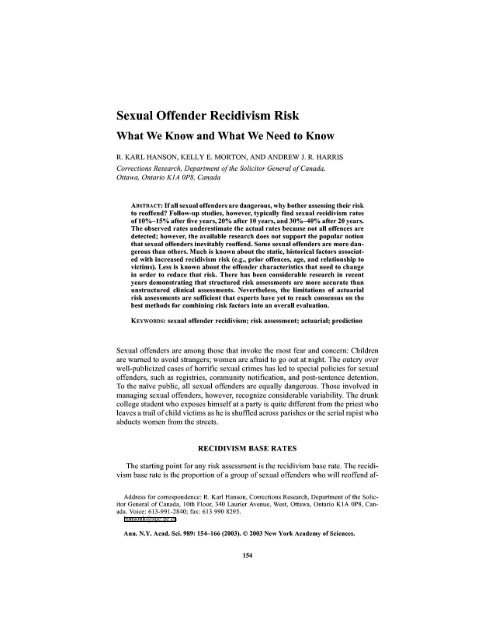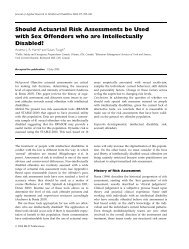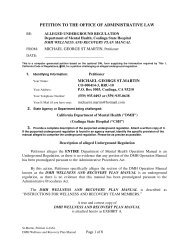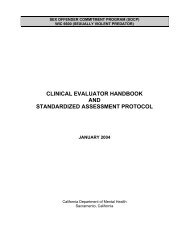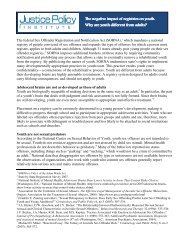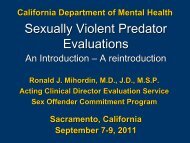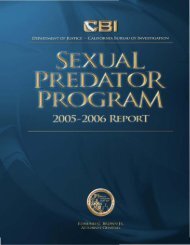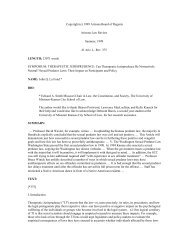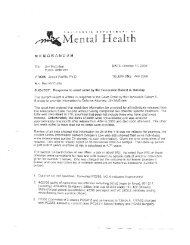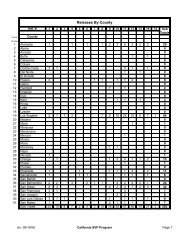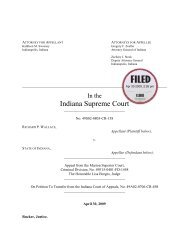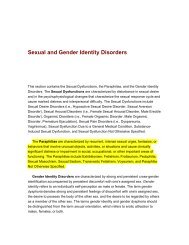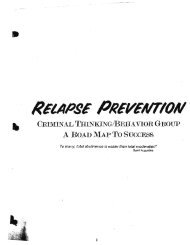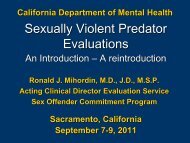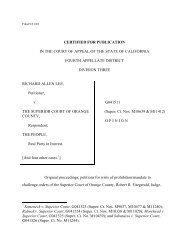Hanson Morton Harris 2003 - Defense for SVP
Hanson Morton Harris 2003 - Defense for SVP
Hanson Morton Harris 2003 - Defense for SVP
You also want an ePaper? Increase the reach of your titles
YUMPU automatically turns print PDFs into web optimized ePapers that Google loves.
Sexual Offender Recidivism Risk<br />
What We Know and What We Need to Know<br />
R. KARL HANSON, KELLY E. MORTON, AND ANDREW J. R. HARRIS<br />
Corrections Research, Department of the Solicitor General of Canada,<br />
Ottawa, Ontario KIA OP8, Canada<br />
ABSTRACT: If all sexual offenders are dangerous, why bother assessing their risk<br />
to reoffend Follow-up studies, however, typically find sexual recidivism rates<br />
oflO%-15% after five years, 20% after 10 years, and 30%-40% after 20 years.<br />
The observed rates underestimate the actual rates because not all offences are<br />
detected; however, the available research does not support the popular notion<br />
that sexual offenders inevitably reoffend. Some sexual offenders are more dangerous<br />
than others. Much is known about the static, historical factors associated<br />
with increased recidivism risk (e.g., prior offences, age, and relationship to<br />
victims). Less is known about the offender characteristics that need to change<br />
in order to reduce that risk. There has been considerable research in recent<br />
years demonstrating that structured risk assessments are more accurate than<br />
unstructured clinical assessments. Nevertheless, the limitations of actuarial<br />
risk assessments are sufficient that experts have yet to reach consensus on the<br />
best methods <strong>for</strong> combining risk factors into an overall evaluation.<br />
KEYWORDS: sexual offender recidivism; risk assessment; actuarial; prediction<br />
Sexual offenders are among those that invoke the most fear and concern: Children<br />
are warned to avoid strangers; women are afraid to go out at night. The outcry over<br />
well-publicized cases of horrific sexual crimes has led to special policies <strong>for</strong> sexual<br />
offenders, such as registries, community notification, and post-sentence detention.<br />
To the naIve public, all sexual offenders are equally dangerous. Those involved in<br />
managing sexual offenders, however, recognize considerable variability. The drunk<br />
college student who exposes himself at a party is quite different from the priest who<br />
leaves a trail of child victims as he is shuffled across parishes or the serial rapist who<br />
abducts women from the streets.<br />
RECIDIVISM BASE RATES<br />
The starting point <strong>for</strong> any risk assessment is the recidivism base rate. The recidivism<br />
base rate is the proportion of a group of sexual offenders who will reoffend af-<br />
Address <strong>for</strong> correspondence: R. Karl <strong>Hanson</strong>, Corrections Research, Department of the Solicitor<br />
General of Canada, 10th Floor, 340 Laurier Avenue, West, Ottawa, Ontario KIA OP8, Canada.<br />
Voice: 613-991-2840; fax: 613 990 8295.<br />
hansonk@sgc.gc.ca<br />
Ann. N.Y. Acad. Sci. 989: 154-166 (<strong>2003</strong>). © <strong>2003</strong> New York Academy of Sciences.<br />
154
HANSON et al.: RISK OF RECIDIVISM<br />
155<br />
100<br />
80<br />
Percentage of<br />
Offenders Who 60<br />
have not<br />
Sexually<br />
40<br />
Recidivated<br />
over time<br />
20<br />
o<br />
o 2 4 6 8 10 12 14 16 18 20 22<br />
Time in Years<br />
FIGURE 1. Sexual recidivism in a sample of 4724 sexual offenders over a twenty-year<br />
period.<br />
ter a period of time (i.e., the follow-up period). If, <strong>for</strong> example, 20 out of 100 sexual<br />
offenders were reconvicted <strong>for</strong> a new sexual offence, the recidivism base rate would<br />
be 20%. This rate can be used to predict how many offenders will reoffend (e.g., 20<br />
out of 100) as well as to estimate the probability that an individual offender will reoffend<br />
(i.e., the "typical" sexual offender has a 20% chance of reoffending).<br />
FIGURE I summarizes the sexual recidivism rate in a mixed group of sexual offenders.<br />
This data set comprises 10 individual samples; the aggregated sample<br />
(n = 4724) is the largest presently available (<strong>Harris</strong> & <strong>Hanson</strong>, 2002). These samples<br />
range in size from 191 to 1138 offenders and were drawn from the following jurisdictions:<br />
Cali<strong>for</strong>nia, Washington, Quebec, Ontario, Manitoba, Alberta, Her Majesty's<br />
Prison Service (England & Wales), and the Correctional Service of Canada (3<br />
distinct samples). Sexual recidivism was defined by a new charge in five samples and<br />
by a new conviction in the remaining five samples. The average follow-up period<br />
was seven years, with approximately 16% of the sample being followed <strong>for</strong> more<br />
than 15 years. FIGURE I expresses sexual recidivism as a "survival curve" (Greenhouse,<br />
Stangl & Bromberg, 1989).<br />
As can be seen in FIGURE I, the five-year recidivism rate was 14% (95% confidence<br />
interval of 13-15%), the 10-year recidivism rate was 20% (95% confidence<br />
interval of 19-21 %), the 15-yearrate was 24% (95% confidence interval of 22-26%)<br />
and the 20-year rate was 27% (95% confidence interval of 24-30%). Although the<br />
cumulative recidivism rates increase with time, the chances that an offender will<br />
eventually "recidivate" decreases the longer he remains offense-free in the community.<br />
The proportion of new recidivists was 14% in the first five years at liberty compared<br />
to only 3% during years 15 to 20.<br />
The sexual recidivism rates <strong>for</strong> rapists (those who have offended against an adult<br />
victim) and child molesters are very similar (FIG. 2). Rapists, however, are much<br />
more likely than child molesters to recidivate with a nonsexual violent offence (<strong>Hanson</strong><br />
& Bussiere, 1998). Among child molesters, those most likely to sexually recid-
156 ANNALS NEW YORK ACADEMY OF SCIENCES<br />
100<br />
80<br />
Percentage of<br />
Offenders 60<br />
Who have not<br />
Sexually<br />
Recidivated<br />
over time<br />
40<br />
20<br />
0<br />
0 2 4 6<br />
- Rapists<br />
~ Child Molesters<br />
8 10 12 14 16<br />
Time in Years<br />
FIGURE<br />
a fifteen-year<br />
2. Sexual recidivism of rapists (n = 1038) and child molesters (n = 2798) over<br />
period<br />
100<br />
Percentage<br />
of<br />
Offenders<br />
Who have not<br />
Sexually<br />
Recidivated<br />
over time<br />
80<br />
60<br />
40<br />
20<br />
-FomilyVictims (N~1.099)<br />
____UirrelatedFemales(N~1.572)<br />
o<br />
o 2 4 6<br />
~UirrelatedMaies<br />
(N~706)<br />
8 10 12 14 16 18<br />
Time in Years<br />
FIGURE 3. Sexual recidivism in a sample of child molesters.<br />
ivate are those who offended against unrelated boy victims, followed by those who<br />
offended against unrelated girl victims and, finally, incest offenders (FIG. 3). Incest<br />
offenders were defined as those with victims within their own family, such as children,<br />
step-children, and nieces.<br />
The available data suggest that most sexual offenders do not recidivate. It is important<br />
to remember, however, that many sexual offenses are never reported to police.<br />
The extent to which the undetected offenses should influence the observed<br />
recidivism rates is a matter of debate. If the typical sexual offender commits many<br />
offenses, then the observed rates should be close to the actual rates. High-frequency
HANSONet al.: RISKOF RECIDIVISM 157<br />
TABLE 1. Predictors of sexual offence recidivism<br />
Risk Factor r n (k)<br />
Sexual deviance<br />
PPG sexual interest in children .32 4853 (7)<br />
Any deviant sexual preference .22 570 (5)<br />
Prior sexual offenses .19 11,294 (29)<br />
Any stranger victims .15 465 (4)<br />
Early onset .12 919 (4)<br />
Any related victims .11 6889(21)<br />
Any boy victims .11 10,294 (19)<br />
Diverse sexual crimes .10 6011 (5)<br />
Criminal history/lifestyle<br />
Antisocial personality .14 811 (6)<br />
Any prior offenses .13 8683 (20)<br />
Demographic factors<br />
Age (young) .13 6969 (21)<br />
Single (never married) .11 2850 (8)<br />
Treatment history<br />
Treatment dropout .17 806 (6)<br />
NOTE:r is the averagecorrelationcoefficientfrom<strong>Hanson</strong>and Bussiere(1998). k is the number<br />
of studies,and n is the total samplesize.<br />
offenders are likely to get caught, even if the probability of detection <strong>for</strong> anyone offense<br />
is small. On the other hand, if the typical sexual offender commits only a few<br />
offences (e.g., 5 or less), then the observed recidivism rates would be expected to<br />
seriously underestimate the actual rates. All experts agree that the observed rates are<br />
minimal estimates, but specifying the amount of underestimation is difficult given<br />
that the phenomenon of interest is, by definition, unobservable. Nevertheless, a reasonable<br />
estimate would be that the actual recidivism rates are at least 10% to 15%<br />
higher than the observed rates (based on the assumptions that 60% (or less) of recidivists<br />
commit 5 (or fewer) new offenses over a 20-year period and that the probability<br />
of detection is 15% per offense). For example, given that the observed 20-year<br />
recidivism rate ranges from 25% to 40%, it is quite likely that the actual recidivism<br />
rates are in the range of 35% to 55%.<br />
RISK FACTORS FOR SEXUAL RECIDIVISM<br />
Not all sexual offenders are equally likely to reoffend. Considerable research has<br />
been conducted identifying those factors that are, and are not, predictive of sexual<br />
recidivism. Most of these studies were summarized in <strong>Hanson</strong> and Bussiere's (1998)<br />
meta-analysis. This review examined 61 unique samples (making up a total of<br />
28,972 sexual offenders), the main results of which are reported in TABLE1. To be<br />
included in the table, each risk factor must have been examined in at least four stud-
158 ANNALS NEW YORK ACADEMY OF SCIENCES<br />
TABLE 2. Factors unrelated to sexual offence recidivism<br />
Risk Factor<br />
Victim empathy<br />
Denial of sex offence<br />
Unmotivated <strong>for</strong> treatment<br />
General psychological problems<br />
Sexually abused as a child<br />
Degree of sexual contact<br />
r<br />
.03<br />
.02<br />
.01<br />
.01<br />
-.01<br />
-.03<br />
n (k)<br />
4670 (3)<br />
762 (6)<br />
435 (3)<br />
655 (6)<br />
5051 (6)<br />
828 (6)<br />
NOTE: r is the average correlation coefficient from <strong>Hanson</strong> and Bussiere (1998). k is the number<br />
of studies, and n is the total sample size.<br />
ies and have an average correlation with sexual recidivism of at least r = .10 (10%<br />
difference in recidivism rates <strong>for</strong> those with or without the characteristic).<br />
The strongest predictors of sexual recidivism are factors related to sexual deviance<br />
and general criminality. <strong>Hanson</strong> and Bussiere (1998) found the single biggest<br />
predictor of sexual offense recidivism was sexual interest in children as measured by<br />
phallometric assessment (penile plethysmograph or PPG). Phallometric assessment<br />
involves the direct monitoring of sexual response when viewing or listening to sexual<br />
stimuli (Launay, 1994). Other important predictors included clinical assessments<br />
of deviant sexual preferences, prior sexual offenses, and a history of selecting unrelated<br />
victims or male victims. General criminality, as measured by the total number<br />
of prior offenses and antisocial personality, is also an important risk factor. It is also<br />
worth noting that the sexual recidivists tend to be single and young (<strong>Hanson</strong>, 2001).<br />
<strong>Hanson</strong> and Bussiere (1998) also identified some characteristics not associated<br />
with sexual recidivism. Some of the findings in TABLE2 were surprising. Clinical<br />
interviews are routinely used in risk assessment, but much of the in<strong>for</strong>mation commonly<br />
assessed in these interviews, such as low victim empathy, denial, and lack of<br />
motivation <strong>for</strong> treatment, were unrelated to sexual offense recidivism. It may be difficult<br />
to assess sincere remorse given the obvious social pressures of the <strong>for</strong>ensic<br />
setting.<br />
COMBINING RISK FACTORS INTO AN OVERALL EVALUATION<br />
No single risk factor is sufficient to predict whether a particular offender will reoffend<br />
or not. Consequently, all competent evaluations consider a range of factors,<br />
each of which could potentially increase or decrease the offender's recidivism potential.<br />
Offenders with all the risk factors are obviously high-risk, and those with no risk<br />
factors are low-risk, but what about the typical offender who has some risk factors<br />
There are several ways that individual factors can be organized into an overall<br />
evaluation. Evaluators using the unstructured clinical approach integrate diverse<br />
material based on theory and their experience with similar cases. In such evaluations,<br />
neither the risk factors considered nor the method of combining the risk factors are<br />
fixed, and are allowed to change from case to case. In structured clinical assessments,<br />
the evaluator specifies in advance the risk factors considered in the evalua-
HANSONet al.: RISKOF RECIDIVISM 159<br />
TABLE 3. Average predictive accuracy of actuarial, empirically guided, and<br />
unstructured clinical assessments<br />
95%<br />
Confidence Numberof TotalSample<br />
Averaged Interval Q Findings Size<br />
Actuarial 0.68 0.62-0.73 113.68*** 50 7145<br />
Empirically guided 0.52 0.33-0.71 12.16* 6 703<br />
clinical<br />
Outlier removed 0.42 0.22-0.62 4.04 5 632<br />
Unstructured clinical 0.28 0.14-0.42 20.93* 12 1851<br />
*p < .05; ***p < .001.<br />
tion. Empirically guided clinical assessments resemble structured clinical<br />
assessments in that both types of evaluation begin with an examination of an explicit<br />
list of risk factors. The distinct feature of the empirically guided clinical approach is<br />
that the risk factors considered are primarily restricted to those with empirical evidence<br />
supporting their relationship with sexual recidivism (e.g., Sexual Violence<br />
Risk-20; Boer, Wilson, Gauthier & Hart, 1997). In the empirically guided approach,<br />
the final evaluation of risk is left to the judgement of the clinician. In contrast, the<br />
actuarial approach not only specifies the risk factors to be considered, but also specifies<br />
the method of combining the factors into an overall evaluation (e.g., Static-99;<br />
<strong>Hanson</strong> & Thornton, 2000). The final method of evaluation, the adjusted actuarial<br />
approach, begins with an actuarial measure and then adjusts the estimated recidivism<br />
risk based on factors exterual to the actuarial scheme (e.g., Violence Prediction<br />
Scheme; Webster, <strong>Harris</strong>, Rice, Cormier & Quinsey, 1994) (TABLE3).<br />
Although actuarial scales have been used with general criminal populations <strong>for</strong><br />
many years (e.g., Hoffman, 1994), actuarial scales specifically designed <strong>for</strong> sexual<br />
offenders have only recently become available (Epperson, Kaul & Huot, 1995; <strong>Hanson</strong>,<br />
1997; Rice & <strong>Harris</strong>, 1997). Consequently, most of the early research examined<br />
clinical assessments that were either unstructured (e.g., Dix, 1976; Hall, 1988; Ryan<br />
& Miyoshi, 1990), structured (Smith & Monastersky, 1986), or empirically guided<br />
(Epperson et aI., 1995). <strong>Hanson</strong> and Bussiere's (1998) review of studies prior to<br />
1996 identified only one study of an actuarial risk scale specifically designed <strong>for</strong><br />
sexual offenders (Epperson et aI., 1995). Since 1996, the research on actuarial risk<br />
scales has increased dramatically such that we are now able to identify at least 50<br />
replication findings of sexual offender risk scales.<br />
FIGURE4 presents the predictive accuracy of various approaches to evaluating<br />
sexual offender recidivism risk. These studies examined sexual recidivism as the<br />
outcome criterion, typically defined as rearrest or reconviction. The results are reported<br />
in terms of Cohen's d, or the standardized mean difference (Hasselblad &<br />
Hedges, 1995). According to Cohen (1988, p. 40), d values of .80 are considered<br />
"large," d values of .50 are considered "medium," and d values of .20 are considered<br />
"small." In FIGURE4, the d values are plotted against the inverse of their variances.<br />
The findings from studies with small samples, or few recidivists, would be expected<br />
to have more variability than the findings from large studies (i.e., a finding on the
160 ANNALS NEW YORK ACADEMY OF SCIENCES<br />
2.5<br />
D<br />
o Actuarial<br />
o Clinical<br />
l:,. Empirical<br />
+ Structured Clinical<br />
"0<br />
1.5<br />
.'"<br />
= tJ<br />
•••<br />
-=Q<br />
U<br />
0.5<br />
Q<br />
DD<br />
D<br />
o<br />
DO<br />
D<br />
QJ<br />
-0.5<br />
0 10 20 30<br />
50<br />
60<br />
70<br />
80<br />
90<br />
Study Weight (inverse of variance)<br />
Note: only 1 case of structured<br />
clinical<br />
FIGURE 4. Accuracy of different approaches to predicting sexual offense recidivism<br />
(k = 38, findings = 69, N = 8545).<br />
right-hand<br />
side of the figure should be more reliable than those on the left-hand<br />
side).<br />
Overall, actuarial risk assessments were significantly more accurate (d = 0.68,<br />
95% confidence interval of 0.62 to 0.73) than unstructured clinical assessments<br />
(d = 0.28, 95% confidence interval of 0.14 to 0.42). The empirically guided clinical<br />
assessment had a level of predictive accuracy intermediate between the two other<br />
approaches (d = 0.52,95% confidence interval of 0.33 to 0.71). There were relatively<br />
few tests of the empirically guided approach, however, and the findings were strongly<br />
influenced by the high level of predictive accuracy found in a single study by<br />
Dempster (d = 1.25; 1998). Removing this outlier resulted in an average predictive<br />
accuracy of d = 0.42 (95% confidence interval of 0.22 to 0.62), with a nonsignificant<br />
Q statistic indicating no more variability across studies than would be expected by<br />
chance. For comparison, a Cohen's d of 0.68 corresponds to a ROC area of 0.68 and a<br />
correlation coefficient of 0.26 (at a 20% base rate). A Cohen's d of 0.28 corresponds<br />
to a ROC area of 0.58 and a correlation coefficient of 0.11 (at a 20% base rate).<br />
The scales with the most replication studies were the Rapid Risk Assessment <strong>for</strong><br />
Sexual Offence Recidivism (RRASOR; <strong>Hanson</strong>, 1997), closely followed by Static-<br />
99 (<strong>Hanson</strong> & Thornton, 2000) then the Sex Offender Risk Appraisal Guide<br />
(SORAG) and the Violence Risk Appraisal Guide (VRAG; Quinsey, <strong>Harris</strong>, Rice &<br />
Cormier, 1998). We were able to locate only one or two replication studies <strong>for</strong> six<br />
other scales: Minnesota Sex Offender Screening Tool (MnSOST; Epperson et aI.,
HANSONet al.: RISKOF RECIDIVISM 161<br />
TABLE 4. Average accuracy of Static-99, RRASOR, VRAG, and SORAG <strong>for</strong><br />
predicting sexual recidivism<br />
95%<br />
Confidence<br />
Number of Total Sample<br />
Averaged Interval Q Findings Size<br />
Static-99 0.76 .65 to .87 38.2*** 15 4202<br />
RRASOR 0.66 .58 to .75 41.2*** 17 5004<br />
VRAG 0.64 .50 to .79 7.65 5 1000<br />
SORAG 0.68 .51 to .86 9.38 5 1104<br />
Outlier removed 0.60 .42to.78 0.39 4 1033<br />
***p
162 ANNALS NEW YORK ACADEMY OF SCIENCES<br />
inogenic needs-those problematic characteristics that need to change in order to<br />
prevent reoffending. Acute risk factors are most important <strong>for</strong> community supervision-being<br />
able to anticipate an imminent offense and intervene appropriately.<br />
Although less is known about dynamic risk factors than static risk factors, recent<br />
research suggests that certain potentially changeable factors, such as intimacy deficits<br />
and attitudes tolerant of sexual assault, provide in<strong>for</strong>mation that is not fully<br />
captured in the existing actuarial risk scales. <strong>Hanson</strong> and <strong>Harris</strong> (2001) found that<br />
the Sex Offender Need Assessment Rating (SONAR, now revised as two scales, the<br />
Stable-2000 and Acute-2000) significantly differentiated recidivists from nonrecidivists<br />
even after controlling <strong>for</strong> scores on the VRAG and Static-99. SONAR contains<br />
items related to negative social influences, intimacy deficits, sexual self-regulation,<br />
attitudes tolerant of sexual assault, and lack of cooperation with supervision. Among<br />
child molesters in community treatment, Beech, Friendship, Erikson, and <strong>Hanson</strong><br />
(2002) found that a questionnaire measure of "deviance" significantly predicted sexual<br />
recidivism after controlling <strong>for</strong> Static-99 scores. Beech's deviance measure addressed<br />
attitudes tolerant of sexual assault and social-affective deficits (e.g.,<br />
loneliness, emotional identification with children). Similarly, Thornton (2002)<br />
found that his "initial deviance" measure also significantly predicted sexual recidivism<br />
after controlling <strong>for</strong> Static-99 scores. Thornton's (2002) initial deviance<br />
assessment included three broad domains of distorted attitudes, socio-affective functioning,<br />
and low self-control.<br />
EFFECTS<br />
OF TREATMENT<br />
An important question is the extent to which treatment can influence recidivism<br />
rates of sexual offenders. There are few well-controlled studies of sexual offender<br />
treatment, and even fewer studies focussing on current <strong>for</strong>ms of treatment. Despite<br />
more than 35 review papers since 1990, and a review of reviews (United States<br />
General Accounting Office, 1996), researchers and policymakers have yet to reach<br />
consensus on whether treatment effectively reduces sexual recidivism.<br />
Furby, Weinrott, and Blackshaw's (1989) narrative review of the early (largely<br />
pre-1980) treatment outcome literature concluded that there was no evidence that<br />
treatment reduced recidivism <strong>for</strong> sexual offenders. Hall's (1995) meta-analysis of 12<br />
treatment outcome studies, which appeared after Furby et al.'s (1989) review, found<br />
a small overall treatment effect (r = .12). Hall concluded that medical treatment and<br />
comprehensive cognitive-behavioral treatment were both effective and superior to<br />
purely behavioral treatments.<br />
Hall's (1995) review, however, has been criticized <strong>for</strong> including studies that compared<br />
treatment completers to treatment dropouts. Such comparisons are difficult to<br />
interpret because those who drop out of treatment would be expected to have characteristics<br />
related to recidivism risk, such as youth, impulsivity, and antisocial personality<br />
(Wierzbicki & Pekarik, 1993). When the dropout studies were removed<br />
from Hall's (1995) meta-analysis, the treatment effect was no longer significant<br />
(<strong>Harris</strong>, Rice & Quinsey, 1998).<br />
Gallagher et al.'s (1999) meta-analysis considered 25 studies examining psychological<br />
or hormonal treatments. Like Hall (1995), they concluded that there was a<br />
significant treatment effect <strong>for</strong> cognitive-behavioral treatments. Unlike Hall (1995),
HANSON et al.: RISK OF RECIDIVISM 163<br />
they found insufficient evidence to support medicallhormonal treatments. The<br />
apparent effectiveness ofmedicallhormonal treatments in Hall's (1995) review could<br />
be attributed to a single study of physical castration (Wille & Beier, 1989).<br />
The most comprehensive review of psychological treatment <strong>for</strong> sexual offenders<br />
is that conducted by the Collaborative Outcome Data Project Committee (<strong>Hanson</strong> et<br />
aI., 2002). This committee was <strong>for</strong>med in 1997 with the goals of organizing the existing<br />
outcome literature <strong>for</strong> sexual offenders and encouraging new evaluation<br />
projects to be conducted in a manner that contributes to cumulative knowledge. The<br />
first report of the Committee concluded that current psychological treatments are<br />
associated with reductions in both sexual and general recidivism. After an average<br />
4-5 years of follow-up, 10% of the offenders in the treatment groups had sexually<br />
"recidivated" compared to 17% of the comparison groups (n = 3,016 from 15 studies).<br />
The reduction in general (any) recidivism was from 51% to 32%. The report<br />
also cautioned, however, that more and better research is required be<strong>for</strong>e firm<br />
conclusions can be reached (see Rice & <strong>Harris</strong>, this volume).<br />
WHAT WE KNOW AND WHAT WE NEED TO KNOW<br />
Considerable research has been conducted on the recidivism rates of sexual offenders.<br />
Overall, the observed rates are between 10% and 15% after 5 years and approximately<br />
20% after 10 years. Given that these findings are from sufficiently large<br />
and diverse samples, new research studies are unlikely to change these estimates any<br />
time in the near future. How to interpret the observed rates, however, remains debatable<br />
given that most sexual offences never appear in official records.<br />
Not all sexual offenders are equally likely to reoffend. Many characteristics have<br />
been reliably associated with increased recidivism risk, including prior sexual offences,<br />
deviant sexual preferences, unrelated victims, male victims, and general<br />
criminal history. As well, researchers have combined these risk factors into actuarial<br />
scales, which now have demonstrated validity <strong>for</strong> the prediction of sexual recidivism.<br />
Most of the established risk factors are static, historical characteristics. A<br />
promising development is that recent research has increasingly supported the relevance<br />
of potentially changeable characteristics, such as intimacy deficits and attitudes<br />
tolerant of sexual assault. Importantly, several studies have demonstrated that<br />
these dynamic factors provide in<strong>for</strong>mation not captured by the existing actuarial<br />
scales.<br />
Much, however, remains to be known. It is possible that many supposedly dynamic<br />
risk factors are actually proxies <strong>for</strong> enduring characteristics that are difficult, if not<br />
impossible, to change (e.g., intimacy deficits as a symptom of personality disorder).<br />
Further research is required that examines how changes in dynamic factors are associated<br />
with changes in recidivism risk. As it stands, evaluators have no empirically<br />
validated method <strong>for</strong> determining whether sexual offenders have benefited from<br />
treatment.<br />
Perhaps the most contentious issue is how best to combine individual risk factors<br />
into an overall evaluation. Unguided clinical opinion is widely practiced and routinely<br />
accepted by the courts, but there is little justification <strong>for</strong> its continued use given<br />
the demonstrated superiority of structured, actuarial risk assessments. Empirically<br />
guided clinical assessments appear to have predictive accuracy intermediate between
164 ANNALS NEW YORK ACADEMY OF SCIENCES<br />
the unguided clinical and the actuarial approaches. The empirically guided approach,<br />
however, may be the best available option <strong>for</strong> many assessment questions<br />
(such as identifying treatment targets) because the available actuarial measures do<br />
not consider enough dynamic (changeable) risk factors<br />
Quinsey et aI. (1998) argue that evaluators should use actuarial measures and only<br />
actuarial measures: any attempt to consider other in<strong>for</strong>mation would simply dilute a<br />
valid assessment. A contrasting position (and Quinsey's previous opinion) is that<br />
evaluators should base their evaluations on actuarial measures, but be willing to adjust<br />
their assessment on the basis of risk factors external to the actuarial scheme<br />
(Webster et aI., 1994). Both approaches are plausible. Evaluators using a pure actuarial<br />
approach must deliberately ignore risk factors known to be associated with the<br />
risk of recidivism. Evaluators adjusting an actuarial prediction do so without empirical<br />
justification.<br />
For the prediction of sexual recidivism, we were unable to locate any studies that<br />
compared unadjusted versus adjusted actuarial prediction. It is interesting to note,<br />
however, that this controversy has been examined and resolved in weather <strong>for</strong>ecasting:<br />
the most accurate weather <strong>for</strong>ecasters are those that adjust the actuarial predictions<br />
(Swets, Dawes & Monahan, 2000). Weather <strong>for</strong>ecasting is an excellent domain<br />
in which to test prediction methods because the feedback is rapid, frequent, and<br />
obvious. As well, the prediction does not influence the outcome. It is difficult to<br />
conduct research that fairly tests the contribution of professional judgement in empirically<br />
in<strong>for</strong>med risk assessments (Litwak, 2001). We believe, however, that it remains<br />
a worthy challenge <strong>for</strong> researchers hoping to improve the assessment and<br />
management of sexual offenders.<br />
REFERENCES<br />
BARBAREE,H.E., SETO,M.C., LANGTON,C.M. & PEACOCK,E.J. (2001). Evaluating the predictive<br />
accuracy of six risk assessment instruments <strong>for</strong> adult sex offenders. Criminal<br />
Justice and Behavior, 28, 490-521.<br />
BEECH, A., FRIENDSHIP,C., ERIKSON,M. & HANSON,R. K. (2002). The relationship<br />
between static and dynamic risk factors and reconviction in a sample of U.K. child<br />
abusers. Sexual Abuse: A Journal of Research and Treatment, 14, 155-167.<br />
BOER,D.P., WILSON,R.J., GAUTHIER,C.M. & HART,S.D. (1997). Assessing risk <strong>for</strong> sexual<br />
violence: Guidelines <strong>for</strong> clinical practice. In C.D. Webster & M.A. Jackson, (Eds.).<br />
Impulsivity: Theory, assessment and treatment (pp. 326-342). New York: Guil<strong>for</strong>d.<br />
COHEN,J. (1988). Statistical power analysis <strong>for</strong> the behavioral sciences. (1988). Hillsdale,<br />
NJ: Erlbaum.<br />
DEMPSTER,R.J. (1998). Prediction of sexually violent recidivism: A comparison of risk<br />
assessment instruments. Unpublished masters thesis, Simon Fraser University, British<br />
Columbia.<br />
DIX, G.E. (1976). Differential processing of abnormal sex offenders: Utilization of Calif ornia's<br />
Mentally Disordered Sex Offender Program. Journal of Criminal Law, Criminology,<br />
& Police Science, 67, 233-243.<br />
EpPERSON,D.L., KAUL,J.D. & HESSELTON,D. (1998, October). Final report of the development<br />
of the Minnesota Sex Offender Screening Tool - Revised (MnSOST-R). Presentation<br />
at the 17th Annual Research and Treatment Conference of the Association <strong>for</strong><br />
the Treatment of Sexual Abusers, Vancouver, B.C., Canada.<br />
EpPERSON,D.L., KAUL,J.D. & HUOT,S.J. (1995, October). Predicting risk of recidivism <strong>for</strong><br />
incarcerated sex offenders: Updated development on the Sex Offender Screening Tool<br />
(SOST). Paper presented at the 14th Annual Research and Treatment Conference of<br />
the Association <strong>for</strong> the Treatment of Sexual Abusers, New Orleans, Louisiana.
HANSON et al.: RISK OF RECIDIVISM 165<br />
FURBY, L., WEINROTT, M.R. & BLACKSHAW, L. (1989). Sex offender recidivism: A review.<br />
Psychological Bulletin, 105, 3-30.<br />
GALLAGHER, C.A., WILSON, D.B., HIRSCHFIELD, P., COGGESHALL, M.B. & MACKENZIE, D.L.<br />
(1999). A quantitative review of the effects of sex offender treatment on sexual reoffending.<br />
Corrections Management Quarterly, 3, 19-29.<br />
GREENHOUSE, J.B., STANGL, D. & BROMBERG, J. (1989). An introduction to survival analysis:<br />
Statistical methods <strong>for</strong> the analysis of clinical trial data. Journal of Consulting<br />
and Clinical Psychology, 57, 536-544.<br />
HALL, G.C.N. (1988). Criminal behavior as a function of clinical and actuarial variables in<br />
a sexual offender population. Journal of Consulting and Clinical Psychology, 56,<br />
773-775.<br />
HALL, G.C.N. (1995). Sexual offender recidivism revisited: A meta-analysis of recent treatment<br />
studies. Journal of Consulting and Clinical Psychology, 63, 802-809.<br />
HANSON, R.K. (2001). Age and sexual recidivism: A comparison of rapists and child<br />
molesters. (User Report 2001-01). Ottawa: Department of the Solicitor General of<br />
Canada.<br />
HANSON, R.K. (1997). The development of a brief actuarial risk scale <strong>for</strong> sexual offense<br />
recidivism. (User Report 97-04). Ottawa: Department of the Solicitor General of<br />
Canada.<br />
HANSON, R.K. (2002). Evaluation of Manitoba s Secondary Risk Assessment. Unpublished<br />
manuscript.<br />
HANSON, R.K. & BUSSIERE, M.T. (1998). Predicting relapse: A meta-analysis of sexual<br />
offender recidivism studies. Journal of Consulting and Clinical Psychology, 66 (2),<br />
348-362.<br />
HANSON, R.K., GORDON, A., HARRIS, A.J.R., MARQUES, J.K., MURPHY, W., QUINSEY, V.L.,<br />
et al. (2002). First report of the collaborative outcome data project on the effectiveness<br />
of psychological treatment <strong>for</strong> sex offenders. Sexual Abuse: A Journal of<br />
Research and Treatment, 14, 169-194.<br />
HANSON, R.K. & HARRIS, A.J.R. (2000). Where should we intervene Dynamic predictors<br />
of sex offense recidivism. Criminal Justice and Behavior, 27, 6-35.<br />
HANSON, R.K. & THORNTON, D. (2000). Improving risk assessments <strong>for</strong> sex offenders: A<br />
comparison of three actuarial scales. Law and Human Behavior, 24(1), 119-136.<br />
HARRIS, A.J.R. & HANSON, R.K. (2002). Recidivism in sexual offenders. Unpublished<br />
manuscript. Solicitor General Canada.<br />
HARRIS, G.T., RICE, M.E. & QUINSEY, V.L. (1998). Appraisal and management of risk in<br />
sexual aggression: Implications <strong>for</strong> criminal justice policy. Psychology, Public Policy,<br />
and Law, 4, 73-115.<br />
HARRIS, G.T., RICE, M.E., QUINSEY, V.L., LALUMIERE, M.L., BOER, D. & LANG, C. (in<br />
press). A multi-site comparison of actuarial risk instruments <strong>for</strong> sex offenders.<br />
Psychological Assessment.<br />
HASSELBLAD, V. & HEDGES, L.V. (1995). Meta-analysis of screening and diagnostic tests.<br />
Psychological Bulletin, 117(1), 167-178.<br />
HOFFMAN, P.B. (1994). Twenty years of operational use of a risk prediction instrument: The<br />
United States Parole Commission's Salient Factor Score. Journal of Criminal Justice,<br />
22, 477-494.<br />
LAUNAY, G. (1994). The phallometric assessment of sex offenders: Some professional and<br />
research issues. Criminal Behaviour and Mental Health, 4, 48-70.<br />
LITWACK, T.R. (2001). Actuarial versus clinical assessments of dangerousness. Psychology,<br />
Public Policy and Law, 7(2), 409-443.<br />
MCGRATH, R.J. & HOKE, S.E. (1994). Vermont Assessment of Sex-Offender Risk. Waterbury,<br />
VT: Author.<br />
NUNES, K.L., FIRESTONE, P., BRADFORD, J.M., GREENBERG, D.M. & BROOM, I. (2002). A<br />
comparison of modified versions of the Static-99 and the Sex Offender Risk<br />
Appraisal Guide (SORAG). Sexual Abuse: A Journal of Research and Treatment 14,<br />
253-269.<br />
PRENTKY, R., HARRIS, B., FRIZZELL, K. & RIGHTHAND, S. (2000). An actuarial procedure <strong>for</strong><br />
assessing risk with juvenile sex offenders. Sexual Abuse: A Journal of Research and<br />
Treatment, 12, 71-93.
166 ANNALS NEW YORK ACADEMY OF SCIENCES<br />
QUINSEY, V.L., HARRIS, G.T., RICE, M.E. & CORMIER, C.A. (1998). Violent offenders:<br />
Appraising and managing risk. Washington, DC: American Psychological Association.<br />
RICE, M.E. & HARRIS, G.T. (1997). Cross-validation and extension of the Violence Risk<br />
Appraisal Guide <strong>for</strong> child molesters and rapists. Law and Human Behavior, 21, 231-<br />
241.<br />
RYAN, G. & MIYOSHI, T. (1990). Summary of a pilot follow-up study of adolescent sexual<br />
perpetrators after treatment. Interchange, I, 6-8.<br />
SMITH, W.R. & MONASTERSKY, C. (1986). Assessing juvenile sexual offenders' risk <strong>for</strong><br />
reoffending. Criminal Justice and Behavior, 13, 115-140.<br />
SWETS, J.A., DAWES, R.M. & MONAHAN, J. (2000). Psychological science can improve<br />
diagnostic decisions. Psychological Science in the Public Interest, I, 1-26.<br />
THORNTON, D. (2002). Constructing and testing a framework <strong>for</strong> dynamic risk assessment.<br />
Sexual Abuse: A Journal of Research and Treatment, 14,139-153.<br />
UNITED STATES GENERAL ACCOUNTING OFFICE. (1996). Sex offender treatment: Research<br />
results inconclusive about what works to reduce recidivism. Washington, DC: Author.<br />
WEBSTER, C., HARRIS, G., RICE, M., CORMIER, C. & QUINSEY, V. (1994). The Violence Prediction<br />
Scheme: Assessing dangerousness in high risk men. Toronto: Centre of Criminology,<br />
University of Toronto.<br />
WIERZBICKI, M. & PEKARIK, G. (1993). A meta-analysis of psychotherapy drop-out. Professional<br />
Psychology: Research and Practice, 24, 190-195.<br />
WILLE, R. & BEIER, K.M. (1989). Castration in Germany. Annals of Sex Research, 2, 103-133.<br />
WONG, S., OLVER, M., WILDE, S., NICHOLAICHUK, T.P. & GORDON, A. (2000, July). Violence<br />
Risk Scale (VRS) & Violence Risk Scale-sex offender version (VRS-SO). Presented at<br />
the 61 st Annual Convention of the Canadian Psychological Association, Ottawa,<br />
Canada.


